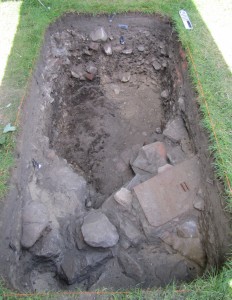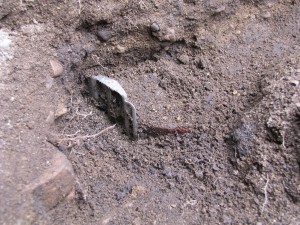By Victoria Cacchione
Our excavation units near Cole’s Hill in Plymouth were placed because this lot may be near the original northern edge of the 17th-century settlement. The lot had a building on it from 1800 to the mid-20th century, but the large back and side yards around the building meant that there were areas where early deposits might be preserved. Prior to 1800, the lot held a house and a blacksmith shop, and earlier there was a lime kiln in the area.
Each of the three excavation units on Cole’s Hill presented its own challenges and questions that required decisions about excavation strategies and provided numerous teachable moments for the student archaeologists. From the beginning, Excavation Unit 1 (EU1) proved to be a complex unit with its multiple contexts each full of distinct artifact types. The student excavators, Kerri, Kerri, and Meredith, have continued to diligently document and carefully remove each layer of soil. In doing so, they uncovered the northern-most limits of the previously known 19th-century dwelling on the property. This foundation wall consists of a jumble of coarse stones that appear to have been dislodged into unstable positions when the structure was demolished after 1920. Knowing this, the archaeologists were faced with deciding how to proceed with their excavations. Do they continue excavating the southern half of their unit that includes the interior of the foundation filled with 20th-century debris? Or do they confine themselves to the northern section of the unit? Ultimately, they decided to continue with excavating solely the northern portion of EU1, the outside of the building. This decision had already yielded a find in the form of a French drain and possible remnants of the cellar bulkhead entry. This find adds to the overall understanding of the occupation and use of Cole’s Hill while also exposing new questions.
Over in Excavation Unit 3 (EU3), the student archaeologists (Victoria, Nadia, and Laura) continually unearthed mysterious and complex artifacts from the beginning of the week until the end of the day Friday. Monday brought the first of many preservation challenges when the students discovered possible preserved organic material (mainly leather and wood), a surprise given the rare instance of such a find archaeologically let alone in New England with its acidic soil. The rarity of such a discovery provided challenges of knowing how to preserve the organics in the summer heat once the excavators removed them from the soil. We quickly became experts in making tin-foil packages of various sizes, wrapped around dust pans, clip boards, and lunch trays in order to create sealed, stable, protective surfaces for these fragile artifacts. Once excavated, the organic materials were whisked away to the nearest refrigerator to keep them from drying out and then taken to UMass Boston and turned over to Dennis Piechota for conservation and examination in the lab. Even when some of the organic objects are not preserved intact, he will be able to provide information about the materials that they were made of. Associated with the organic materials are small finds of female personal adornment pieces and sewing equipment dating to the late 19th century. However, these findings again prove to present more questions than answers. How and why were these artifacts deposited? Archaeologists hope to answer these questions with continued excavations and research.
Not to be left out, Excavation Unit 5 (EU5) also exposed the challenges of urban archaeology and provided a lesson in excavation safety. Professor David Landon described this unit as the epitome of urban archaeology as the unit measures three feet deep and is still full of destruction rubble. For instance, one moment the archaeologists shared their excitement over uncovering 17th-century ceramics; the next, the presence of a mid nineteenth century sherd of ceramic dashes all traces of celebration as it indicates the context is a fill layer. It seems that the units crosses the line of a filled cellar from an earlier, previously unknown building on the site that was filled after the new house was built in 1800.
Nevertheless, the finding of 17th-century artifacts is an exciting indication of possible earlier occupation of the site. In addition to its lessons on urban archaeology, EU3 also provided the student archaeologists with an example of how to navigate voids in the soil. Voids in the soil could be the result of burrowing animals, or small air pockets between loose rubble, or large air pockets in an incompletely filled structure. In instances where soil disappears into these abysses, it is always wise to be aware and carefully determine the depth of such voids. Luckily, the voids in EU5 were small gaps in the rubble fill and did not pose a threat to the archaeologists. The archaeologists working on Cole’s Hill hope to answer some if not all of the questions this week’s excavations presented as they wrap up this session of the Plymouth Field School.
Victoria Cacchione is a student in the MA program in Historical Archaeology at UMass Boston.




